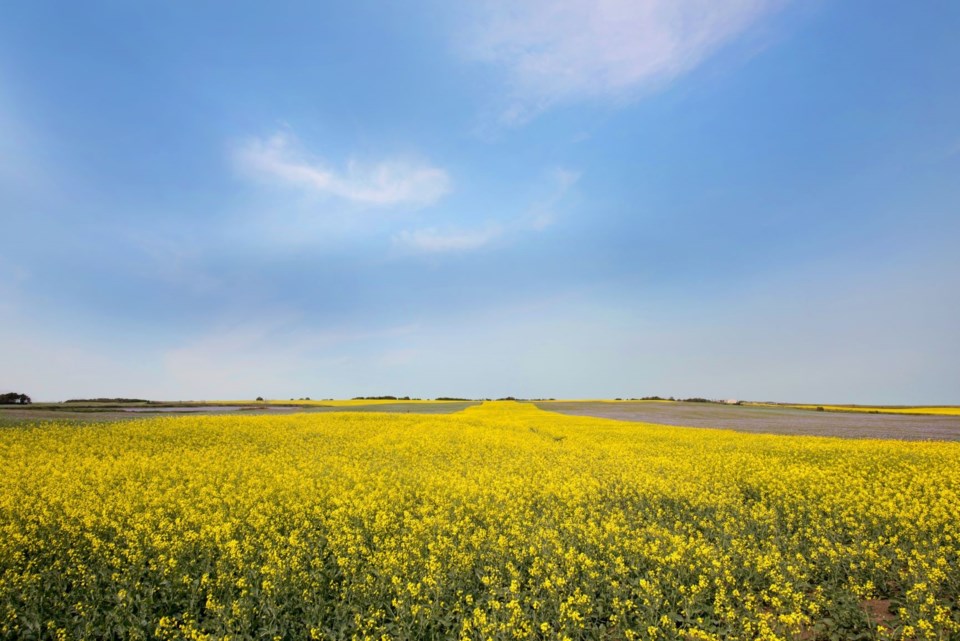Crops remain in relatively good condition and are advancing quickly, thanks to recent rain and warm weather.
Provincially, 89 per cent of fall cereals, 77 per cent of spring cereals, 74 per cent of oilseeds and 84 per cent of pulse crops are at their normal stages of development for this time of year. With further hot temperatures in the forecast, many crops are expected to quickly catch up. Some crops in southern areas are beginning to dry-down and local producers expect harvest operations to begin in the coming weeks.
East-Central Saskatchewan:
Crop District 5 – Melville, Yorkton, Cupar, Kamsack, Foam Lake, Preeceville and Kelvington areas
Crop District 6A – Lumsden, Craik, Watrous and Clavet areas
Crops continue to advance quickly in the east-central region, although some fields remain a bit behind their normal developmental stages for this time of year. Scattered showers and hot temperatures in the forecast will help crops catch up. Many crops are in good to excellent condition thanks to recent rainfall but additional moisture will be needed soon to help crops fill and to improve hay and pasture land growth.
The region received rainfall last week that ranged from trace amounts to 51 mm in the Kuroki area. The Stalwart and Esterhazy areas received 22 mm of rain, the Lipton and Rama areas six mm, the Yorkton and Jedburgh areas 18 mm, the Kelliher area four mm, the Pelly area 30 mm, the Lumsden area 14 mm, the Bulyea area 10 mm and the Kenaston area 13 mm. The Kuroki area has received the most precipitation in the region since April 1 (248 mm).
Topsoil moisture conditions have deteriorated in the last week. Cropland topsoil moisture is rated as one per cent surplus, 75 per cent adequate and 24 per cent short. Hay and pasture land topsoil moisture is rated as 65 per cent adequate and 35 per cent short. Crop District 6A is reporting that 25 per cent of the cropland and 49 per cent of the hay and pasture land is short topsoil moisture at this time. Rainfall would be welcomed to help alleviate stress from lack of moisture.
Hay crops are slow to dry down with the recent moisture and high humidity but haying continues when weather permits. Livestock producers currently have 21 per cent of the hay crop cut and 14 per cent baled or put into silage. Hay quality is rated as eight per cent excellent, 68 per cent good, 12 per cent fair and 12 per cent poor. Overall, hay yields are much less than normal and many producers do not expect a second cut at this time.
Most crop damage this past week was due to localized flooding, lack of moisture and insects such as wheat midge. Many producers continue to spray fungicides for diseases such as fusarium head blight, sclerotinia and leaf spots.
Farmers are busy haying, hauling grain, applying pesticides and scouting for disease and insects.
Provincially, rainfall varied throughout the province this past week with many regions receiving at least half an inch. The Kuroki area in the east central region received the greatest amount of rainfall with 51 mm.
Cropland topsoil moisture is rated as four per cent surplus, 84 per cent adequate, 11 per cent short and one per cent very short. Hay and pasture land topsoil moisture is rated as three per cent surplus, 74 per cent adequate, 18 per cent short and five per cent very short.
Haying continues in between rain showers, although frequent rain and high humidity has prevented dry-down of many hay crops. Livestock producers now have 22 per cent of the hay crop cut and 20 per cent baled or put into silage. Hay quality is currently rated as 10 per cent excellent, 65 per cent good, 18 per cent fair and seven per cent poor.
Hay yields have been below normal for many producers and most are unsure if a second cut is possible this year. Estimated average dryland hay yields at this time are 1.3 tons per acre for alfalfa, 1.2 tons per acre for alfalfa/bromegrass, 1.0 tons per acre for other tame hay, 0.8 tons per acre for wild hay and 1.8 tons per acre for greenfeed. Estimated average irrigated hay yields are 2.4 tons per acre for alfalfa, 2.5 tons per acre for alfalfa/bromegrass and 2.0 tons per acre for greenfeed.
Crop damage this past week was attributed to localized flooding, hail, strong winds and lack of moisture. Diseases such as root rot, ascochyta and other leaf spots are being scouted while insects such as grasshoppers are being sprayed. Many producers continue to spray fungicides on crops as weather and field conditions permit.
Farmers are busy haying, applying fungicides, scouting for disease and insects and getting equipment ready for harvest.
A complete, printable version of the Crop Report is available online at https://www.saskatchewan.ca/crop-report.
Follow the 2020 Crop Report on Twitter at @SKAgriculture.

